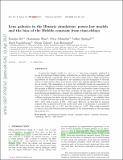| dc.contributor.author | Xu, Dandan | |
| dc.contributor.author | Sluse, Dominique | |
| dc.contributor.author | Schneider, Peter | |
| dc.contributor.author | Springel, Volker | |
| dc.contributor.author | Vogelsberger, Mark | |
| dc.contributor.author | Nelson, Dylan | |
| dc.contributor.author | Hernquist, Lars | |
| dc.date.accessioned | 2017-04-27T18:07:10Z | |
| dc.date.available | 2017-04-27T18:07:10Z | |
| dc.date.issued | 2015-12 | |
| dc.date.submitted | 2015-10 | |
| dc.identifier.issn | 0035-8711 | |
| dc.identifier.issn | 1365-2966 | |
| dc.identifier.uri | http://hdl.handle.net/1721.1/108459 | |
| dc.description.abstract | A power-law density model, i.e. ρ(r)∝r [superscript −gamma prime], has been commonly employed in strong gravitational lensing studies, including the so-called time-delay technique used to infer the Hubble constant H0. However, since the radial scale at which strong lensing features are formed corresponds to the transition from the dominance of baryonic matter to dark matter, there is no known reason why galaxies should follow a power law in density. The assumption of a power law artificially breaks the mass-sheet degeneracy, a well-known invariance transformation in gravitational lensing which affects the product of Hubble constant and time delay and can therefore cause a bias in the determination of H0 from the time-delay technique. In this paper, we use the Illustris hydrodynamical simulations to estimate the amplitude of this bias, and to understand how it is related to observational properties of galaxies. Investigating a large sample of Illustris galaxies that have velocity dispersion σSIE ≥ 160 km s−1 at redshifts below z = 1, we find that the bias on H0 introduced by the power-law assumption can reach 20–50 per cent, with a scatter of 10–30 per cent (rms). However, we find that by selecting galaxies with an inferred power-law model slope close to isothermal, it is possible to reduce the bias on H0 to ≲ 5 per cent and the scatter to ≲ 10 per cent. This could potentially be used to form less biased statistical samples for H0 measurements in the upcoming large survey era. | en_US |
| dc.language.iso | en_US | |
| dc.publisher | Oxford University Press | en_US |
| dc.relation.isversionof | http://dx.doi.org/10.1093/mnras/stv2708 | en_US |
| dc.rights | Creative Commons Attribution-Noncommercial-Share Alike | en_US |
| dc.rights.uri | http://creativecommons.org/licenses/by-nc-sa/4.0/ | en_US |
| dc.source | arXiv | en_US |
| dc.title | Lens galaxies in the Illustris simulation: power-law models and the bias of the Hubble constant from time delays | en_US |
| dc.type | Article | en_US |
| dc.identifier.citation | Xu, Dandan; Sluse, Dominique; Schneider, Peter; Springel, Volker; Vogelsberger, Mark; Nelson, Dylan and Hernquist, Lars. “Lens Galaxies in the Illustris Simulation: Power-Law Models and the Bias of the Hubble Constant from Time Delays.” Monthly Notices of the Royal Astronomical Society 456, no. 1 (December 17, 2015): 739–755. | en_US |
| dc.contributor.department | Massachusetts Institute of Technology. Department of Physics | en_US |
| dc.contributor.mitauthor | Vogelsberger, Mark | |
| dc.relation.journal | Monthly Notices of the Royal Astronomical Society | en_US |
| dc.eprint.version | Author's final manuscript | en_US |
| dc.type.uri | http://purl.org/eprint/type/JournalArticle | en_US |
| eprint.status | http://purl.org/eprint/status/PeerReviewed | en_US |
| dspace.orderedauthors | Xu, Dandan; Sluse, Dominique; Schneider, Peter; Springel, Volker; Vogelsberger, Mark; Nelson, Dylan; Hernquist, Lars | en_US |
| dspace.embargo.terms | N | en_US |
| dc.identifier.orcid | https://orcid.org/0000-0001-8593-7692 | |
| mit.license | OPEN_ACCESS_POLICY | en_US |
| mit.metadata.status | Complete | |
